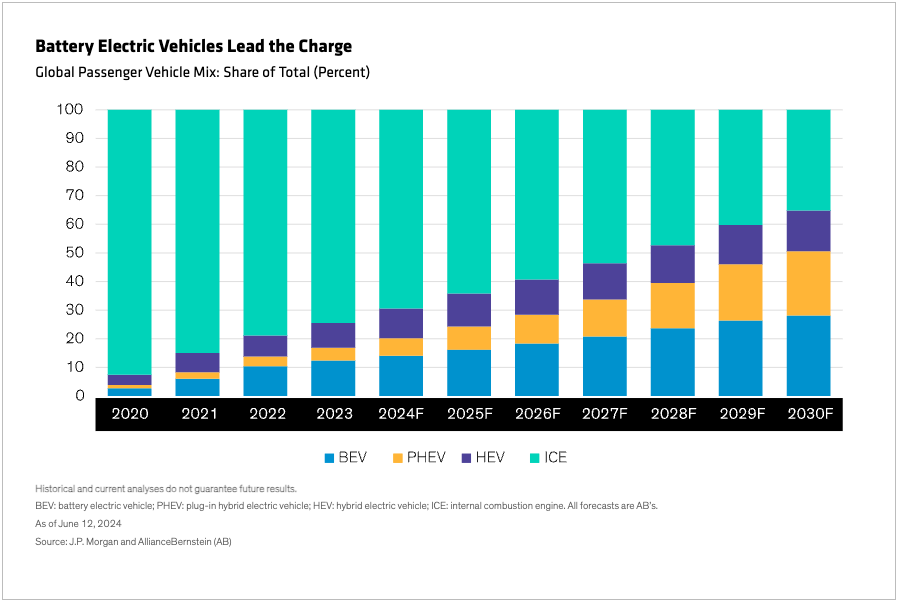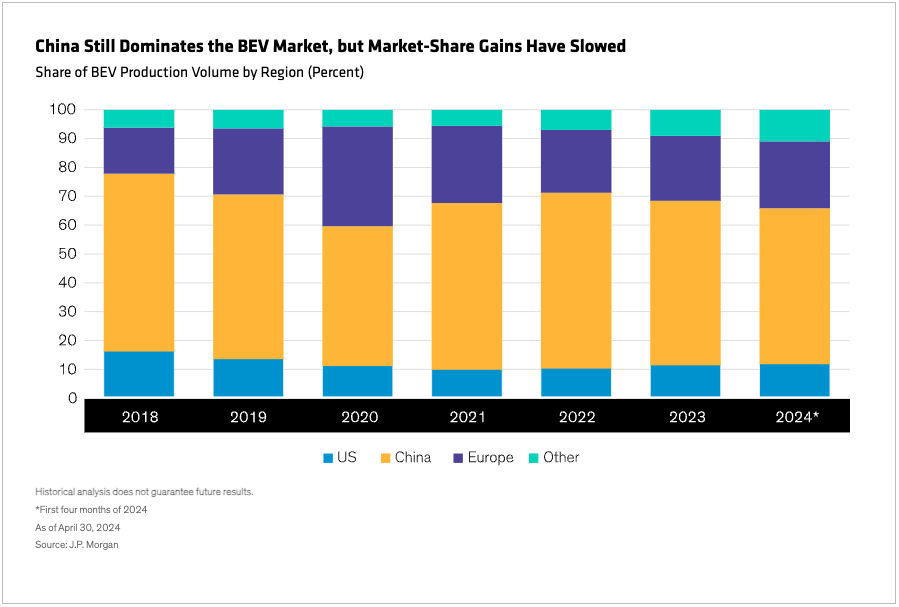AllianceBernstein: Winding Road Ahead for China’s EV Growth
Lily Zheng| Portfolio Manager—China Net Zero Solutions; Senior Research Analyst
Kathleen Dumes, CFA| Responsible Investing Research Analyst—Fixed Income Responsible Investing
What do near-term pressures on China’s battery electric vehicle industry mean for its long-term outlook?
China has quickly risen to dominate the global battery electric-vehicle (BEV) industry, both as a manufacturer and as a market. Its dominance looks set to continue, but the industry—in China and elsewhere—faces headwinds. The challenge for investors is to understand and navigate the short-term risks and to position themselves for long-term opportunities.
The trend in global autos away from internal combustion engines (ICE) to electric vehicles (EVs) is well established and is forecast to grow as countries continue efforts to reduce their carbon dioxide emissions. Among EVs, the strong growth in BEVs—as distinct from hybrid electric vehicles and plug-in hybrid electric vehicles—looks set to continue (See display 1 above).
China dominates the BEV segment in terms of both manufacturing and market demand. But its output in this area, while still well ahead of that of other countries, has recently slowed (See display 2 above).
This reflects a change in the dynamics of the industry’s growth. To understand the investment implications, it helps to know a little about how China came to dominate the BEV industry, and how the growth outlook is, in our view, becoming more nuanced.
Rapid Rise Hits Speed Bumps
China’s rise to BEV dominance began in the early 2000s, when the government realized that the country’s traditional ICE auto manufacturing base, while strong, was unlikely to overtake the US, European and Japanese automakers. As Japan already had an advantage in hybrid vehicles, one area in which China was likely to compete strongly was BEVs.
This new technology required large-scale innovation and investment. The government—motivated by environmental as well as economic benefits—provided generous subsidies. It even imported competition to stimulate growth, by allowing BEV maker Tesla and other Western auto companies to set up factories in China.
The government also boosted manufacturers of BEVs’ most crucial component: batteries. China is now a leader in lithium iron phosphate (LFP) batteries which, before advances made possible by Chinese research, had been considered inferior to the lithium nickel manganese cobalt batteries favored in the West.
In 2023, China produced 6.2 million BEVs, more than half the global total of 11.2 million and many more than Western Europe (2 million), the United States (1.2 million) and Japan (87,000). But there have been speed bumps: the number of Chinese BEV makers peaked at 500 in 2019 and has since fallen to 100 or so. More rationalization is expected, for a number of reasons.
China’s BEV Makers Face Short-Term Challenges
BEV sales growth has recently slowed, mostly due to competition within China from cheaper plug-in hybrids and limited battery-charging infrastructure in China’s lower-tier cities.
This has led to price-cutting and moves to protect margins. At the same time, China’s BEV exports, which have grown strongly since 2020, are meeting resistance in key markets, with higher tariffs imposed by the European Union (EU), Canada and the US.
These are short- to medium-term challenges; we think the longer-term outlook is more encouraging. The impact of Western trade barriers, for example, may be softened by strong growth in Chinese BEV exports to emerging markets. More fundamentally, the Chinese BEV industry has reached the scale, quality and sophistication it needs to compete effectively in the long term.
Structural Advantages May Help in the Long Term
This does not seem to be well understood outside China. The aim of the US tariffs, for example, is to counter “extensive subsidies and non-market practices” that have supported China’s BEV exports. But, as of 2023, China’s EV manufacturers no longer receive national subsidies, and subsidies for the sale of EV batteries ended in 2018.
The country’s leadership in LFP batteries and dominance of the battery supply chain, from raw materials to production, are key structural advantages, in our analysis. LFPs’ cheapness keeps vehicle prices low, and their relative safety is a selling point. Many US BEV makers source their batteries from South Korea and elsewhere, which involves supply-chain risks and small-scale, high-cost suppliers.
We think a major risk for US and European automakers is that tariffs on Chinese BEVs could ease the pressure on them to improve their own EV batteries, and that they may rely instead on their traditional dominance of the large but low-growth ICE markets. Long-term, we see China’s low-cost, high-quality BEVs as challenging ICE makers and forcing them to lower their prices and accept thinner margins.
Next Consolidation Could Yield Opportunities
The Chinese BEV industry is following the growth trajectory of older Chinese industries such as home appliances, textiles and machinery—fast, subsidized growth in the early stages followed by price competition and rationalization. The next phase of consolidation may take time, given the number of players still in the industry (See display 3 above).
In our view, investors should monitor these changes and look for early signs—such as moderating price competition, stable market share and strong cash flows—that the industry is maturing. As we see it, the key will to be to research the market and individual companies intensively and to invest selectively.
This also applies to investing in US and European automakers, which face short-term risks. US automakers must grow their EV businesses to secure their long-term futures, but rating agencies and investors demand strong cash flow and profitability. The EU’s climate goals put its automakers at risk of penalties if sales of EVs—which are currently margin dilutive—don’t increase significantly.
We believe that Western automakers will continue to evolve their business models and differentiate themselves in response to the greening of global transportation. As the global market develops, we regard Chinese BEV makers with integrated battery operations, and battery manufacturers with a broad spread of clients both inside China and globally, as companies worth watching.
The views expressed herein do not constitute research, investment advice or trade recommendations and do not necessarily represent the views of all AB portfolio-management teams. Views are subject to revision over time.
Learn more about AB’s approach to responsibility here.





